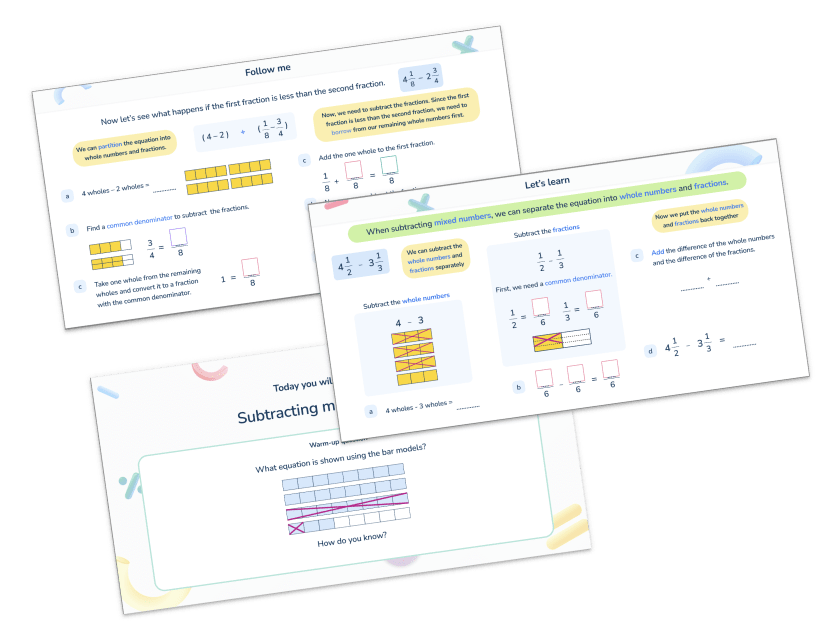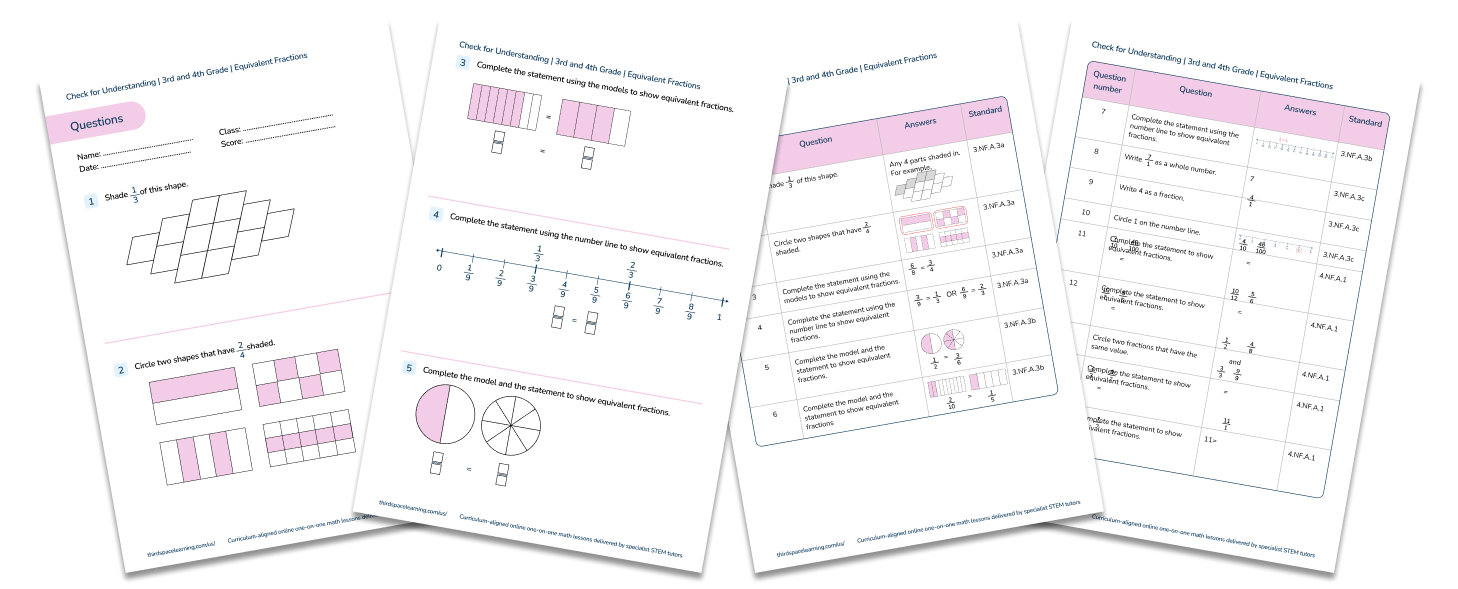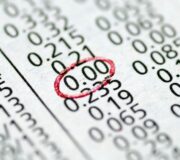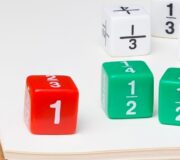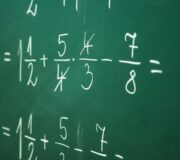What Are Equivalent Fractions? Explained For Elementary School
Equivalent fractions come up a lot in elementary school and some children can be a little unsure as to what they are. This article is aimed at teachers to help make things a little clearer.
Equivalent Fractions Check for Understanding Quiz
Download this quiz to check your 3rd and 4th grade students’ understanding of equivalent fractions.
Download Free Now!What are equivalent fractions?
Equivalent fractions are two or more fractions that are all equal even though they have different numerators and denominators. For example, the fraction \, \cfrac{1}{2} \, is equivalent to (or the same as) \, \cfrac{25}{50} \, or \, \cfrac{500}{1000} \, .
Each time the fraction in its simplest form is ‘one half’.
Remember, a fraction is a part of a whole: the denominator (bottom number) represents how many equal parts the whole is split into; the numerator (top number) represents the amount of those parts.
To understand equivalent fractions, make sure you know the basics of fractions
If the concept of equivalent fractions already sounds a bit confusing and you’re not yet clear on what the difference is between whole numbers, denominators of a fraction, and different numerators, you may want to loop back to our fractions for kids article. This breaks down the first fraction steps that children learn at school, together with clear examples of how to find the value of a fraction using concrete resources, math manipulatives, visual representations, and number lines; the difference between unit fractions and non-unit fractions; all the way up to proper and improper fractions.
It’s been written as a guide for children and parents to work through together in clear digestible chunks.
Examples of equivalent fractions
Here are some examples using a bar model and showing the numerator as the shaded “parts” out of the “whole” i.e. the denominator.
\, \cfrac{4}{6} \, = four out of six parts, also shown as a:

Although \, \cfrac{8}{12} \, may look like a different fraction, it is actually equivalent to \, \cfrac{4}{6} \, because eight out of 12 parts is the same as four out of six parts, as shown below:

\, \cfrac{2}{3} \, , or two out of three, is another fraction equivalent to both \, \cfrac{4}{6} \, and \, \cfrac{8}{12} \, .

How to create equivalent fractions
How is it that two fractions that look completely different represent the same value? That is because when you take a fraction in simplest form, you keep the proportions of that fraction the same by multiplying the numerator and the denominator by the same number. By doing this, you are in fact multiplying this fraction by 1, and we know that multiplying by 1 doesn’t change the original value of the number, so the fraction will be equivalent.
For example, you can multiply by \, \cfrac{2}{2} \, or \, \cfrac{6}{6} \, and you’re still multiplying by 1.
Equivalent fractions to \, \cfrac{3}{5} \,
\, \cfrac{3}{5} \, x \, \cfrac{2}{2} \, = \, \cfrac{6}{10} \,
\, \cfrac{3}{5} \, x \, \cfrac{3}{3} \, = \, \cfrac{9}{15} \,
\, \cfrac{3}{5} \, x \, \cfrac{4}{4} \, = \, \cfrac{12}{20} \,
So, \, \cfrac{3}{5} \, = \, \cfrac{6}{10} \, = \, \cfrac{9}{15} \, = \, \cfrac{12}{20} \, .
Equivalent fractions to \, \cfrac{3}{5} \,
\, \cfrac{3}{5} \, x \, \cfrac{2}{2} \, = \, \cfrac{6}{10} \,
\, \cfrac{3}{5} \, x \, \cfrac{3}{3} \, = \, \cfrac{9}{15} \,
\, \cfrac{3}{5} \, x \, \cfrac{4}{4} \, = \, \cfrac{12}{20} \,
So, \, \cfrac{3}{5} \, = \, \cfrac{6}{10} \, = \, \cfrac{9}{15} \, = \, \cfrac{12}{20} \, .
Another way to find equivalent fractions is to divide both the numerator and the denominator of the fraction by the same number – this is called simplifying fractions because both the numerator and denominator digits will get smaller.
For example, to simplify the fraction \, \cfrac{9}{12} \, , find a number that both the numerator and denominator can be divided by (also known as a ‘common factor’), such as 3.
\, \cfrac{9}{12} \, ÷ \, \cfrac{3}{3} \, = \, \cfrac{3}{4} \, , so \, \cfrac{9}{12} \, and \, \cfrac{3}{4} \, are equivalent fractions, with \, \cfrac{3}{4} \, being the fraction in its simplest form. We know it is in its simplest form because 3 and 4 do not have any other factors in common besides 1.
Equivalent Fractions Check for Understanding Quiz
Download this quiz to check your 3rd and 4th grade students’ understanding of equivalent fractions.
Download Free Now!When do children learn about equivalent fractions in elementary school?
The concept isn’t introduced until third grade, when children recognize and show equivalent fractions with small denominators using diagrams and number lines.
In fourth grade, they will recognize and show families of common equivalent fractions using diagrams. They will explain why a given fraction is equivalent to another and use this principle to recognize and generate equivalent fractions. They will start to apply this concept to the addition and subtraction of tenths with hundredths.
In fifth grade, they will begin adding and subtracting fractions and mixed numbers with different denominators, using the concept of equivalent fractions. Students are encouraged to find the least common denominator between two fractions before solving to make the calculations simpler. They can do this by listing out equivalent fractions until they find the least common denominator.

Meet Skye, the voice-based AI tutor making math success possible for every student.
Built by teachers and math experts, Skye uses the same pedagogy, curriculum and lesson structure as our traditional tutoring.
But, with more flexibility and a low cost, schools can scale online math tutoring to support every student who needs it.
Find out moreHow do equivalent fractions relate to other areas of math?
Children will need to have a strong knowledge of equivalent fractions to be able to convert between fractions, decimals, and percentages. Knowledge of multiplication facts, the least common multiple and greatest common factor are also important. The understanding of equivalent fractions also introduces students to proportional relationships that are connected with ratios, geometric similarities, and balancing algebraic equations.
Wondering about how to explain other key math vocabulary to your children? Check out our Math Dictionary For Kids And Parents, or try these other terms related to equivalent fractions:
- What Is A Unit Fraction?
- What Is PEMDAS?
- Properties of shapes
- What are 2D shapes?
- What are 3D shapes?
Equivalent fractions questions
1. Write the missing values: \, \cfrac{3}{4} \, = \, \cfrac{9}{?} \, = \, \cfrac{?}{24} \,
(Answer: 12, 18)
2. Circle the two fractions that have the same value:
\, \cfrac{2}{10} \, \, \cfrac{1}{3} \, \, \cfrac{1}{2} \, \, \cfrac{5}{10} \, \, \cfrac{1}{4} \,(Answer: \, \cfrac{1}{2} \, and \, \cfrac{5}{10} \, )
3. Tick two shapes that have \, \cfrac{3}{4} \, shaded.
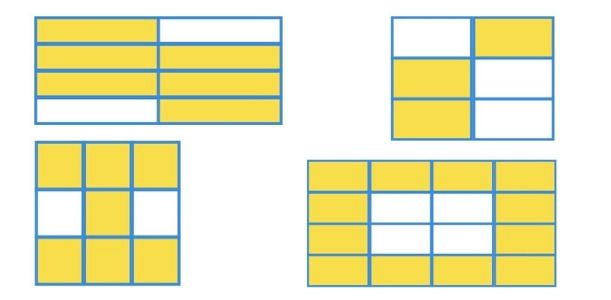
(Answer: top left ( \, \cfrac{6}{8} \, ) and bottom right ( \, \cfrac{12}{16} \, ) as both = \, \cfrac{3}{4} \, )
4. Shade \, \cfrac{1}{4} \, of this shape.
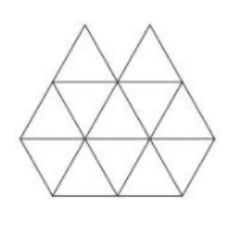
(Answer: Any 3 triangles shaded)
5. Ahmed says, ‘one-third of this shape is shaded.’ Is he correct? Explain how you know.

(Answer: Yes – it would be \, \cfrac{2}{6} \, (imagine the middle square split into halves too) which = \, \cfrac{1}{3} \, )
Looking for extra support? See our fraction worksheets blog for a selection of grade-appropriate FREE resources designed by math experts.
In math, ‘equivalent’ means that two (or more) values, quantities, etc. are the same.
They are fractions that may look different but actually represent the same quantity. 2/3 and 6/9 are examples of equivalent fractions.
They can be explained as fractions that have different numerators and denominators but represent the same value.
Do you have students who need extra support in math?
Skye—our AI math tutor built by experienced teachers—provides students with personalized one-on-one, spoken instruction that helps them master concepts, close skill gaps, and gain confidence.
Since 2013, we’ve delivered over 2 million hours of math lessons to more than 170,000 students, guiding them toward higher math achievement.
Discover how our AI math tutoring can boost student success, or see how our math programs can support your school’s goals:
– 3rd grade tutoring
– 4th grade tutoring
– 5th grade tutoring
– 6th grade tutoring
– 7th grade tutoring
– 8th grade tutoring
The content in this article was originally written by primary school teacher Sophie Bartlett and has since been revised and adapted for US schools by elementary math teacher Jaclyn Wassell.
